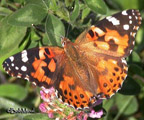Native Plants
Search for native plants by scientific name, common name or family. If you are not sure what you are looking for, try the Combination Search or our Recommended Species lists.
Cirsium discolor
Cirsium discolor (Muhl. ex Willd.) Spreng.
Field Thistle
Asteraceae (Aster Family)
Synonym(s): Carduus discolor
USDA Symbol: CIDI
USDA Native Status: L48 (N), CAN (N)
Field Thistle is a member of the aster family (family Asteraceae) which includes herbs, sometimes shrubs or vines, rarely trees, with simple or compound, alternate or opposite leaves. Flowers small, but organized into larger heads resembling a single, radially symmetrical flower cupped by a ring of green bracts. Flower-like heads: tiny, radially symmetrical central flowers form the disc; larger flowers around the edge, the rays, strap-shaped and resembling petals; however, all flowers in one head may be disc flowers or rays.
Plant Characteristics
Duration: BiennialHabit: Herb
Size Notes: Height 80-200 cm.
Fruit: Brown. Fruit is a cypsela (pl. cypselae). Though technically incorrect, the fruit is often referred to as an achene.
Bloom Information
Bloom Color: Pink , PurpleBloom Time: Jun , Jul , Aug , Sep
Distribution
USA: AL , AR , CT , DC , DE , GA , IA , IL , IN , KY , LA , MA , MD , ME , MI , MN , MO , MS , NC , ND , NH , NJ , NY , OH , PA , RI , SC , SD , TN , VA , VT , WI , WVCanada: MB , NB , NS , ON , QC
Growing Conditions
Light Requirement: SunSoil Moisture: Dry
Benefit
Use Wildlife: Goldfinches are fond of this thistle seed.Conspicuous Flowers: yes
Attracts: Butterflies
Larval Host: Painted Lady
Value to Beneficial Insects
Special Value to Native BeesSpecial Value to Bumble Bees
Provides Nesting Materials/Structure for Native Bees
This information was provided by the Pollinator Program at The Xerces Society for Invertebrate Conservation.
Butterflies and Moths of North America (BAMONA)
|
Painted Lady (Vanessa cardui)  Larval Host |
National Wetland Indicator Status
| Region: | AGCP | AK | AW | CB | EMP | GP | HI | MW | NCNE | WMVE |
| Status: | UPL | UPL | FACU | FACU | UPL |
From the National Organizations Directory
According to the species list provided by Affiliate Organizations, this plant is on display at the following locations:Mt. Cuba Center - Hockessin, DE
Bibliography
Bibref 1186 - Field Guide to Moths of Eastern North America (2005) Covell, C.V., Jr.Bibref 1185 - Field Guide to Western Butterflies (Peterson Field Guides) (1999) Opler, P.A. and A.B. Wright
Bibref 1294 - The Midwestern Native Garden: Native Alternatives to Nonnative Flowers and Plants An Illustrated Guide (2011) Adelman, Charlotte and Schwartz, Bernard L.
Search More Titles in Bibliography
Additional resources
USDA: Find Cirsium discolor in USDA PlantsFNA: Find Cirsium discolor in the Flora of North America (if available)
Google: Search Google for Cirsium discolor
Metadata
Record Modified: 2022-12-23Research By: TWC Staff